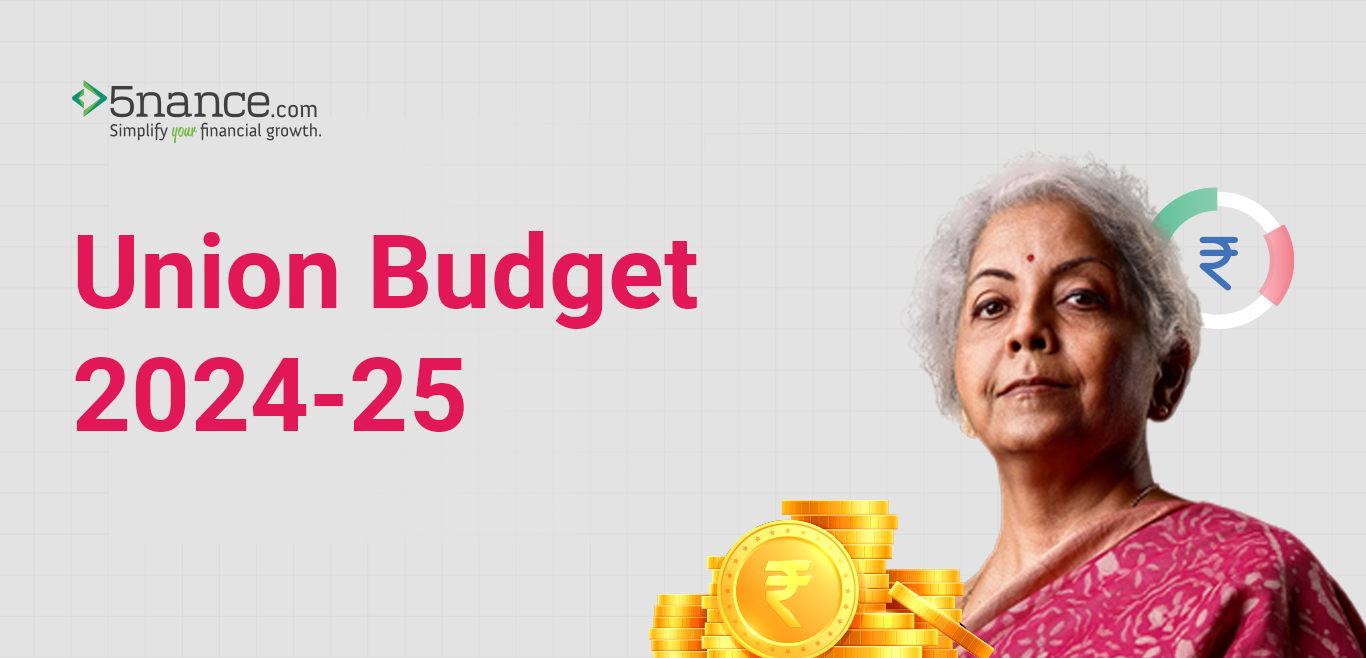
The Interim Union Budget for the FY2024-25 seems to have taken most people by surprise. It appears that the Government has taken its time to tactfully pen down sectors and areas that need immediate attention. Finance Minister Nirmala Sitharaman rightfully stated that India has weathered many storms to transform its economic situation within the last decade.
Let’s take a deeper look at the highlights of the Interim Union Budget 2024.
Macro Highlights
Domestic GDP: The budget pegged the nominal GDP growth rate for FY24-25 at 10.5% which came in-line with market estimates.
Deficits: The most positive surprise in the budget was fiscal deficit target pegged at 5.1% for FY25 that adheres to the fiscal glide path.
Government Borrowings: Gross market borrowing is lowered to Rs. 14.1 lakh crore via a bond in FY25, and net borrowing of Rs. 11.75 lakh crore.
Revenue Receipt: A total revenue receipt for FY25 is revised to Rs. 38.8 lakh crore higher than budgeted.
The target of Divestment in FY25 is Rs. 50,000 crores.
Key Insights into the Interim Budget 2024-25
The capital allocation or CAPEX for the FY25 was hiked by 11.1% to Rs. 11.11 lakh crore, accounting for 3.4% of the domestic GDP.
The average monthly gross Goods & Tax (GST) collection doubled to Rs. 1.66 lakh crore in FY24, indicating a resilient domestic economy.
In-line with Housing theme, the new housing scheme will be made available for middle-class and 2 core more houses under PMAY-Gramin.
The scheme on Direct Benefit Transfers has led to savings of Rs 2.7 lakh crore for the government, and crop insurance was given to 4 crore farmers under PM Fasal Bima Yojana.
The government integrated 1,361 mandis with Rs. 3 lakh crores in trading volume with a vision for inclusion of farmers in the growth story of India.
There will be no tax liability for individuals with income up to Rs. 7 lakhs under the new tax regime, which is now the default taxing system.
Allocation of Funds to Ministries
|
Ministry Name |
INR (in lakh crore) |
|
Defence |
6.2 |
|
Road Transport and Highways |
2.78 |
|
Railways |
2.55 |
|
Consumer Affairs, Food & Public Distribution |
2.13 |
|
Home Affairs |
2.03 |
|
Rural Development |
1.77 |
|
Chemicals and Fertilisers |
1.68 |
|
Communications |
1.37 |
|
Agriculture and Farmers’ Welfare |
1.27 |
Proposed Allocation for the Major or Flagship Govt. Schemes
|
Scheme Name |
Rs. In Cr. |
|
Mahatma Gandhi National Rural Employment Guarantee Scheme |
86,000 |
|
Ayushman Bharat-PMJAY |
7,500 |
|
Production Linked Incentive Scheme |
6,200 |
|
Modified Programme for Development of Semiconductors and display manufacturing ecosystem |
6,903 |
|
Solar Power (Grid) |
8,500 |
|
National Green Hydrogen Mission |
600 |
Sectors in Focus during the Interim Budget
Infrastructure (Positive)
The increase in FY25 Capex allocation by 11.1% to Rs. 11.11 lakh crore is expected to boost the infra-based allied sectors including the housing, road, cement etc. The capital outlay accounts for 3.4% of the GDP.
The government intends to execute three significant railway corridor programs to enhance logistics efficiency and lower costs.
The UDAN scheme will oversee the expansion of current airports and the comprehensive development of new airports.
The Metro rail and NaMo Bharat projects will drive urban transformation.
The number of airports is set to double, reaching a total of 149. Indian carriers have initiated orders for 1,000 new aircraft, providing a significant boost to the public transportation sector.
Housing
The Pradhan Mantri Awas Yojana (Grameen) is nearing the goal of providing 3 crore houses, and an additional target of 2 crore houses is set for the next 5 years.
A scheme will be introduced to facilitate home ownership for the middle class, encouraging them to either purchase or construct their own houses.
Agriculture and Food Processing (Positive)
The government aims to encourage both private and public investment in post-harvest activities.
The utilization of is scheduled to be extended across all agro-climatic regions.
A strategy for the Atmanirbhar Oilseeds Abhiyaan will be devised to achieve self-sufficiency in oilseeds.
The implementation of aqua schemes to get intensified, to boost aquaculture productivity, double exports, and create additional employment opportunities.
Additionally, there are plans to establish 5 integrated aqua parks.
Green Energy
The government aims to fortify the Electric Vehicle (EV) ecosystem by backing manufacturing and charging infrastructure.
In a bid to encourage environmentally sustainable development, a novel bio-manufacturing scheme is set to be introduced.
The Rooftop solar scheme to help one crore people get free electricity.
Social Schemes & Initiatives, And Financing
The government aims to increase the target budget for Lakhpati Didi Yojana from 2 crore to 3 crore.
Ayushman Bharat will cover ASHA, Anganwadi workers. Maternal, Child-care schemes under one plan.
The Government will build 2 crore houses in the next five years and extend to middle class population.
The Govt. offers Rs. 1 lakh crore corpus with a 50-year interest free loan to boost tech-savvy growth.
There are no changes in direct, and indirect taxation.
Conclusion
The Interim Budget 2024 remarkably highlights the thrust of the Government to make India a sustainable developed nation. It is foreseeable that a significant portion of the Rs. 1 lakh crore interest-free loans will be allocated to states supporting technology, innovation, research, tourism to ensure sustained capital expenditure. The pursuit of fiscal consolidation suggests that Indian bond yields will likely remain within a defined range until the next election. The goal to upgrade 40,000 wagons is poised to generate demand for various wagon processing companies, contributing to the positive narrative surrounding railways.




